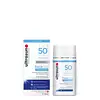What's inside
What's inside
 Key Ingredients
Key Ingredients

 Benefits
Benefits

 Concerns
Concerns

 Ingredients Side-by-side
Ingredients Side-by-side

Water
Skin ConditioningCaprylic/Capric Triglyceride
MaskingPentylene Glycol
Skin ConditioningGlycerin
HumectantMethylene Bis-Benzotriazolyl Tetramethylbutylphenol
UV FilterTitanium Dioxide
Cosmetic ColorantEthylhexyl Salicylate
UV AbsorberBis-Ethylhexyloxyphenol Methoxyphenyl Triazine
Skin ConditioningC12-15 Alkyl Benzoate
AntimicrobialDiethylamino Hydroxybenzoyl Hexyl Benzoate
UV FilterSilica
AbrasiveEthylhexyl Triazone
UV AbsorberAcrylates Copolymer
Squalane
EmollientCocoglycerides
EmollientHydrogenated Phosphatidylcholine
EmulsifyingC8-22 Alkyl Acrylates/Methacrylic Acid Crosspolymer
Ectoin
Skin ConditioningDecyl Glucoside
CleansingVitis Vinifera Seed Extract
AntimicrobialCetyl Alcohol
EmollientPropyl Alcohol
SolventCetyl Phosphate
EmulsifyingXanthan Gum
EmulsifyingAlcohol
AntimicrobialLecithin
EmollientSodium Hydroxide
BufferingPropylene Glycol
HumectantLepidium Sativum Sprout Extract
Skin ConditioningTocopheryl Acetate
AntioxidantAscorbyl Tetraisopalmitate
AntioxidantTocopherol
AntioxidantDiisopropyl Adipate
EmollientUbiquinone
AntioxidantWater, Caprylic/Capric Triglyceride, Pentylene Glycol, Glycerin, Methylene Bis-Benzotriazolyl Tetramethylbutylphenol, Titanium Dioxide, Ethylhexyl Salicylate, Bis-Ethylhexyloxyphenol Methoxyphenyl Triazine, C12-15 Alkyl Benzoate, Diethylamino Hydroxybenzoyl Hexyl Benzoate, Silica, Ethylhexyl Triazone, Acrylates Copolymer, Squalane, Cocoglycerides, Hydrogenated Phosphatidylcholine, C8-22 Alkyl Acrylates/Methacrylic Acid Crosspolymer, Ectoin, Decyl Glucoside, Vitis Vinifera Seed Extract, Cetyl Alcohol, Propyl Alcohol, Cetyl Phosphate, Xanthan Gum, Alcohol, Lecithin, Sodium Hydroxide, Propylene Glycol, Lepidium Sativum Sprout Extract, Tocopheryl Acetate, Ascorbyl Tetraisopalmitate, Tocopherol, Diisopropyl Adipate, Ubiquinone
Zinc Oxide 12%
Cosmetic ColorantWater
Skin ConditioningC12-15 Alkyl Benzoate
AntimicrobialPropanediol
SolventJojoba Esters
EmollientTridecyl Salicylate
Skin ConditioningMethylheptyl Isostearate
Skin ConditioningPolyglyceryl-4 Diisostearate/Polyhydroxystearate/Sebacate
EmulsifyingNylon-12
Niacinamide
SmoothingMethylpropanediol
SolventCoco-Caprylate
EmollientSilica
AbrasiveSodium Chloride
MaskingPolyglyceryl-2 Dipolyhydroxystearate
Skin ConditioningCaprylyl Glycol
EmollientBisabolol
MaskingAllantoin
Skin ConditioningOryza Sativa Bran Extract
Skin ConditioningLecithin
EmollientPhenylpropanol
MaskingHelianthus Annuus Extract
EmollientTocopherol
AntioxidantRosmarinus Officinalis Leaf Extract
AntimicrobialTetrasodium Glutamate Diacetate
Isostearic Acid
Cleansing1,2-Hexanediol
Skin ConditioningSodium Hydroxide
BufferingZinc Oxide 12%, Water, C12-15 Alkyl Benzoate, Propanediol, Jojoba Esters, Tridecyl Salicylate, Methylheptyl Isostearate, Polyglyceryl-4 Diisostearate/Polyhydroxystearate/Sebacate, Nylon-12, Niacinamide, Methylpropanediol, Coco-Caprylate, Silica, Sodium Chloride, Polyglyceryl-2 Dipolyhydroxystearate, Caprylyl Glycol, Bisabolol, Allantoin, Oryza Sativa Bran Extract, Lecithin, Phenylpropanol, Helianthus Annuus Extract, Tocopherol, Rosmarinus Officinalis Leaf Extract, Tetrasodium Glutamate Diacetate, Isostearic Acid, 1,2-Hexanediol, Sodium Hydroxide
Ingredients Explained
These ingredients are found in both products.
Ingredients higher up in an ingredient list are typically present in a larger amount.
C12-15 Alkyl Benzoate is made up of Benzoic Acid and long chain alcohols. It has a low molecular weight.
C12-15 Alkyl Benzoate is an emollient and texture enhancer. Due to its solubility, it is often used in sunscreens to help evenly distribute active ingredients.
As an emollient, C12-15 Alkyl Benzoate helps soften and hydrate your skin. Emollients create a film on your skin that traps moisture within.
This ingredient has been reported to cause eye irritation.
Learn more about C12-15 Alkyl BenzoateLecithin is a term for a group of substances found in the cell membranes of plants, animals, and humans. They are made up of mixture of phospholipids.
This ingredient has emollient and emulsifying properties.
As an emollient, lecithen helps soften the skin and creates a barrier to keep moisture in.
As an emulsifier, it also helps prevent water and oil ingredients from separating. Lecithin can also help ingredients be better absorbed by the skin.
This is because the phospholipids in lecithin produce liposomes. Liposomes help other ingredients get through the skin barrier.
Depending on the source of this ingredient, lecithin may not be fungal acne safe. This is because some sources of lecithin come from soybean oil, which may feed the malassezia yeast that feeds fungal acne.
We recommend reaching out to the brand you are purchasing from to inquire about the source of their lecithin.
Some other names for this ingredient include soy lecithin and deoiled soy lecithin.
Learn more about LecithinSilica, also known as silicon dioxide, is a naturally occurring mineral. It is used as a fine, spherical, and porous powder in cosmetics.
Though it has exfoliant properties, the function of silica varies depending on the product.
The unique structure of silica enhances the spreadability and adds smoothness, making it a great texture enhancer.
It is also used as an active carrier, emulsifier, and mattifier due to its ability to absorb excess oil.
In some products, tiny microneedles called spicules are made from silica or hydrolyzed sponge. When you rub them in, they lightly polish away dead skin layers and enhance the penetration of active ingredients.
Learn more about SilicaSodium Hydroxide is also known as lye or caustic soda. It is used to adjust the pH of products; many ingredients require a specific pH to be effective.
In small amounts, sodium hydroxide is considered safe to use. However, large amounts may cause chemical burns due to its high alkaline.
Your skin has a natural pH and acid mantle. This acid mantle helps prevent harmful bacteria from breaking through. The acid mantle also helps keep your skin hydrated.
"Alkaline" refers to a high pH level. A low pH level would be considered acidic.
Learn more about Sodium HydroxideTocopherol (also known as Vitamin E) is a common antioxidant used to help protect the skin from free-radicals and strengthen the skin barrier. It's also fat soluble - this means our skin is great at absorbing it.
Vitamin E also helps keep your natural skin lipids healthy. Your lipid skin barrier naturally consists of lipids, ceramides, and fatty acids. Vitamin E offers extra protection for your skin’s lipid barrier, keeping your skin healthy and nourished.
Another benefit is a bit of UV protection. Vitamin E helps reduce the damage caused by UVB rays. (It should not replace your sunscreen). Combining it with Vitamin C can decrease sunburned cells and hyperpigmentation after UV exposure.
You might have noticed Vitamin E + C often paired together. This is because it is great at stabilizing Vitamin C. Using the two together helps increase the effectiveness of both ingredients.
There are often claims that Vitamin E can reduce/prevent scarring, but these claims haven't been confirmed by scientific research.
Learn more about TocopherolWater. It's the most common cosmetic ingredient of all. You'll usually see it at the top of ingredient lists, meaning that it makes up the largest part of the product.
So why is it so popular? Water most often acts as a solvent - this means that it helps dissolve other ingredients into the formulation.
You'll also recognize water as that liquid we all need to stay alive. If you see this, drink a glass of water. Stay hydrated!
Learn more about Water